New GAO Report on Wireless
Noting that FCC already does an annual Wireless Competition Report and has been changing its structure to keep up with the times, GAO also suggests:
FCC could do more to examine whether or not there is effective competition in the wireless industry. By collecting and analyzing more detailed data on industry inputs and outputs that reflect industry dynamics, FCC could better assess competition conditions throughout the industry. Specifically, FCC could collect more detailed data on such issues as prices, special access rates, and capital expenditures and include analysis of that information in its annual report. These metrics help measure the competitiveness of small and regional carriers, can shed light on the impact of switching costs for consumers, and are, therefore, relevant to monitoring competition in the industry. Despite challenges and costs in gathering these data, such information could help FCC better fulfill statutory reporting requirements. With consumers increasing reliance on wireless services as their primary telephone and Internet connection, more is needed to ensure that FCC and the Congress have sufficient information to make policy decisions concerning the wireless industry.
Long time readers may recall multiple discussions here about the need to radically change cellular carrier’s approach to antenna design to make suburban antennas more compatible with their environments. GAO comments on this general topic:
According to many national wireless carriers, tower companies, and other stakeholders with whom we spoke, the most common barrier to building out a wireless network is local zoning policies and procedures which can delay or otherwise hinder the physical construction and improvement of wireless networks. Wireless carriers must generally obtain state and local zoning approvals before building wireless towers or attaching equipment (co-location) to preexisting structures. Although these zoning processes do not always pose a challenge to wireless carriers and tower companies, in some instances they can encumber buildout by denying zoning permits or by making the process for constructing cellular towers and antennas cost prohibitive. Many stakeholders with whom we spoke said that in California, for example, there continues to be significant public concern over the aesthetic and health impacts of wireless infrastructure. As a result, locating wireless facilities can be challenging in cities such as San Diego and San Francisco. Other stakeholders told us that, as wireless networks have expanded into residential areas, residents have raised concerns about aesthetics and safety, making it difficult to provide the capacity necessary to serve the growing demand for wireless services. Washington, D.C., and other cities with unique or historic buildings and skylines can also impose limitations on network build out, such as height restrictions on towers.
Local governments and wireless entities have generally been able to reach agreements on the conditions of wireless network construction, despite the challenges noted above. Some local jurisdictions have developed ordinances specifically for wireless infrastructure in order to make their preferences and requirements clear to carriers and tower companies. Carriers have also developed and adopted a variety of disguising or “stealthing” technologies that help mask towers and other infrastructure. Figure 14 shows a stealth tower in Eureka, California, where the antennas were hidden inside a bell tower on church grounds. In San Francisco, to avoid aesthetic concerns and procedural challenges, wireless carriers have developed Distributed Antenna Systems in recent years. Instead of using large towers or antennas on buildings, these systems involve a series of small antennas, deployed low to the ground, often on utility poles, that together provide wireless coverage.
NAB and RIAA - Thanks for Creating Some Exciting News in the Normally Quiet August
Telecom and techie bloggers would normally have little to do during August when both FCC and Congress basically go on vacation. But fortunately NAB and RIAA have taken this normally dull news period and made it exciting with their proposal to require all cell phones -- and possibly other types of personal electronics -- to include what you have always been yearning for: an FM receiver! We bloggers are very grateful to NAB and RIAA for their help at this normally quiet period.
The picture at top is from the CBS News website where a CNET commentator really cuts into the proposal predicting that once Steve Jobs hears about it, he will just kill it since he is Master of the Universe. (Does CBS risk being kicked out of NAB for hosting such heresy?)
In memory of the late Fairness Doctrine, here as a link to the Radio Business Report/Television Business Report “Voice of the Broadcasting Industry” website which has a more rational discussion of the topic than NAB who declared the wireless industry’s letter to Congress to be “anti-radio”. (Fortunately, this blog has never been labeled with that dread description.)
However, RBR comes up with a surprising piece of legal research: “Remember also, the Communications Act of 1934 enables the FCC without Congressional intervention to set all of the technical standards for radio receivers, let alone two-way radio receivers -- a.k.a. cell phones.” Even NAB’s well respected legal staff was not able to come to this conclusion simply because there is no such provision in current legislation! (We will gladly print any input arguing otherwise)
But, the other side makes much more interesting reading:
Digital Tends: Will Uncle Sam Shove an FM Radio in Your Cell Phone
AppleInsider: NAB, RIAA seek to push FM radio into iPods and iPhones
Public Knowledge: Despite the RIAA/NAB Unholy Alliance to Force FM Radios Into All Cell Phones, Performance Royalties Are Still a Good Idea
ExtraTorrent: RIAA Demands Cell Phone Makers to Install FM Tuner
Daily Tech: RIAA and Broadcasters Look to Tell U.S. Government to Mandate Radios in Cell Phones
”Whether it's suing dead people or simply suing living ones for millions of dollars for illegally downloading a few tracks, media watchdog the Recording Industry Association of America (RIAA) seems to gravitate towards controversy like a moth to a flame. The divisive organization is back at it again, this time demanding that the U.S. government impose a drastic mandate on cell phone production.”
techdirt:
Will The NAB Agree To A Performance Rights Tax In Exchange For Having RIAA Support Mandatory FM Radio In Mobile Phones?
(from the rearranging-deck-chairs dept)
We've discussed, for quite some time now, the ridiculousness of a performance rights tax on radio. This is the attempt, by the record labels, to get radio stations to pay performers for advertising and promoting their music. This is clearly not needed, because in the real world, without this, record labels already know that radio play is valuable: it's why they keep running payola scams. For them to try to then legally mandate that money should flow in the opposite direction is downright ridiculous. In what world does the government make someone pay to promote someone else?
After years and years fighting this, we should have known that the NAB would come up with some ridiculous idea in the end. The NAB, which represents broadcasters, is almost always on the wrong side of policy debates (that's what happens when your job is to protect a dying industry), but on this one issue we agreed... until now. Rumors are circulating that the NAB is willing to cave on performance rights, if the RIAA, in exchange, supports a totally wasteful plan to require FM radio receivers be placed in mobile phones, MP3 players and other digital devices. Now, everyone involved says no deal is done yet, but there are multiple indications that this is exactly where the conversation is heading.
So congratulations to NAB for getting this publicity in August that you really could not even buy! We hope your TV members appreciate how this action shows positively on the whole broadcast industry and its dedication to public service. MSTV must be happy that the “good cop/bad cop” dichotomy between the two organizations is diminishing with NAB’s bold legislative proposal for its radio members.
But in the interest of breaking this log jam, here is a bold new proposal from your blogger: Anti immigrant fever is now very popular and any real control of the “undocumented” will require a national ID system, mandatory carrying of such an ID, and regular spot checks - without ethnic profiling, of course. Why not just combine an FM radio mandate with the a new national ID card!
The RadioMuseum website shows a 1986 Casio FM receiver that is as large of two credit cards stacked on top of each other. Certainly with the technical progress of the past 14 years this can be reduced to maybe 1.5 credit cards (or less) and could also have a high tech national ID card incorporated. Then everyone will be required to carry an FM receiver subject to arrest by Sheriff Arpaio for not carrying it. Wouldn’t that be better than just the proposed NAB/RIAA cell phone mandate? You would be arrested for not carrying an FM receiver! Law enforcement could check for both FM radios and undocumented aliens at the same time. That would be real government efficiency addressing 2 key goals at the same time.
UPDATE: NAB Fights Back!
ZeroPaid.com: Radio Pres: Forced Cell Phone FM Tuner is “Pro-Consumer”
National Association of Broadcasters executive vice president Dennis Wharton blasts critics for using usual “Washington-style tactics” that are “long on exaggeration, rhetoric and factual inaccuracies,” and cites evidence of a growing radio audience as proof that “cell phone subscribers deserve access to radio’s free service.” Says opposition is a “simple case of anti-competitive behavior.” ...
I think he’s trying to paint critics with the Washington tag in order to make them seem outside the mainstream, but I think it’s safe to say that most critics are average folks leery about govt mandating design requirements instead of the likes of tech companies like Apple or Motorola. If consumers really wanted an FM tuner they’d seek out those handsets that have them.
But the new winner of the most humorous treatment of this mess is ZatzNotFunny.com for some clever artwork:

Bang out Morse code distress messages from your Sprint EVO MC
Do FCC Commissioners Not Like Doing Enforcement?

Under current legislation, enforcement is an integral part of the FCC’s job. But it is a lot more fun creating new services and issuing licenses than it is penalizing people for antisocial actions. But as Comm. Abernathy said above during her tenure at FCC, the two go hand in hand.
Thus it is interesting to note the current list of Items on Circulation. There are now 32 items on circulation on the 8th Floor - a major decrease over the historic level! Of the 19 items that have been on circulation for more than 3 months, 8 appear to be enforcement related. These include 3 from the June-September 2008 period that have now spent almost 2 years on the 8th Floor without resolution. The list of all items on circulation more than 3 months is below:

So on today, the 6 month anniversary of our enforcement complaint being on the circulation list, we will not complain about that. But we ask what is served by having these other matters pending for such a long period. Note that this date shown below is only the date that the agenda item reached the 8th Floor. Each issue probably was pending for a long time before it ever got to that high level.
Sounds of Silence
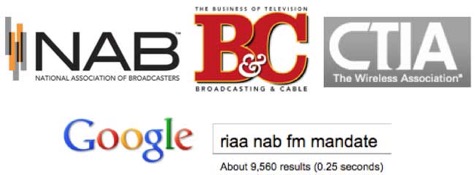
As shown above, Google can find lots of information about the “wacky idea” of NAB and RIAA to mandate FM receivers in cell phones and certain other personal electronics to help settle their music royalty dispute. I’m sure most Americans would be glad to pay extra to carry around something they don’t want and makes their cell phone bulkier in order for these trade associations to kiss and make up. Most Americans feel trade association comity is a key issue and would be glad to help out.
Oddly, three usually very talkative entities, shown above, are strangely silent on the issue. CTIA is reported to be against the proposal, but their website is silent. Broadcasting & Cable, the broadcasting industry’s cheerleader - masquerading as journalism - is also devoid of information.
Finally, coconspirator NAB is also strangely silent on the issue of FM receivers, although they have a page on the “Performance Tax” issue that lead to the bizarre deal with RIAA. The ad at left was part of NAB’s campaign on this issue. Glad to know that they don’t “need a bailout” from the government. An unnecessary mandate on consumers would be adequate to appease NAB.
NAB’s website discussion ends with this:
Action Needed
Congress should oppose a congressionally mandated performance tax on free, local radio broadcasters that would jeopardize local jobs, prevent new artists from breaking into the recording business and harm the 239 million Americans who rely on local radio.
Doesn’t mention that FM receivers in cell phones are part of the solution. Maybe the news of the deal leaked before the NAB spin doctors could tidy up their website.
We will be glad to print or link NAB’s explanation when they figure it out. I am sure B&C will echo it as soon as they get their marching orders from 1771 N Street NW.
CTIA’s silence is more puzzling. Perhaps they are trying to negotiate and don’t want to be as confrontational as CEA.
UPDATE 1
While writing this I tried to call NAB for an opinion/statement, but just got routed from one person to another. However, an e-mail inquiry produced
following quote from NAB Executive Vice President of Communications Dennis Wharton.
"We think that from a public safety perspective, it is critically important to have broadcast radio’s unparalleled lifeline service available instantaneously in times of emergency. For that reason, NAB would oppose any legislation related to royalties that did not include that feature.”
On background, a few things to keep in mind:
-- Radio is a reliable, free and local lifeline service in times of crisis, and in a society where cell phones and other mobile devices are increasingly ubiquitous, it makes sense to have radio-enabled chips in these devices from a public safety perspective; Not to get too dramatic about this, but there were photos that I wish I’d saved from the NY Times on 9/11 of people huddled around car radios and boomboxes to get the latest information;
-- When mass-produced, this feature would cost pennies per cellphone;
-- Many cellphones already have radio capability. They have just not been activated yet by the manufacturer;
-- “Tagging” of music is a feature that many consumers would enjoy, possible providing a new revenue stream to cellphone providers, record labels and radio stations;
-- Putting an FM chip in a cellphone frees up network capacity for the cellphone provider that was previously employed by the consumer for streaming audio features like Pandora and iHeartRadio.You might also be interested in the attached letter, sent last November, by 60 U.S. House representatives from both sides of the aisle to FCC Chairman Julius Genachowski and Secretary of Homeland Security Janet Napolitano. The letter advocates that FM radio capability be added to all mobile phones sold in the United States, citing safety and emergency warning alert concerns. (See attached)
NAB’s Wharton told the Washington Post’s Rob Pegoraro in an e-mail:
From a public safety perspective, it is critically important to have broadcast radio's unparalleled lifeline service available instantaneously in times of emergency. For that reason, NAB would oppose any legislation related to royalties that did not include that feature.
Pegoraro commented in the Post:
Somehow, the broadcasters did not think to make such a request earlier, even though an entire generation of Americans has grown up thinking "phone" means "mobile phone." So either the NAB has only recently begun to put a higher value on human life, or it thinks spending other people's money--that of phone manufacturers, the carriers who sell their products and their customers--will sell this proposal to its members.
Kristopher M. Jones, NAB Vice President, Media Relations added “One last thing: The assertion that radio is a "horse and buggy" dying technology is belied by Arbitron, which recently reported that the number of over-the-air radio listeners per week is now at an all-time high, at 239 million. That’s up 7 million in just the last year. http://arbitron.mediaroom.com/index.php?s=43&item=693 “
NAB: The “November” letter, actually September 2009, got no attention in the broadcasting press, not even it its lapdog Broadcasting & Cable. If FM broadcasting is doing so well, why do we need this mandate? Chmn. Genachowski has responded to the Congressmen who sent the letter saying that the issue will be folded into an ongoing docket on Commercial Mobile Alert System, Docket 07-287. He also stated,
“As you may be aware, on April 9, 2008, the Commission released its First Report and Order adopting technologically neutral rules for the CMAS. In that Order, the Commission considered the comments filed by supporters of FM-based emergency alert technologies, and ultimately concluded that it would "not require or prohibit the use of ALERT-FM ... or similar systems as the basis of the CMAS." CMAS participants, then, are free to adopt FM-based technologies as they desire.”
So, NAB, why do we need legislation at this moment? What is wrong with the current technological neutrality? What does RIAA and “performance tax” have to do with this? What relationship does royalty legislation have with public safety? Isn’t this just a bailout - the thing you decried in your ad?
I was hoping to listen in in the 8/23 NAB “virtual town hall” on radio issues, but sadly they have now closed it to nonmembers.
UPDATE 2 8/24
NAB finally broke its silence on its website with the following item:
NAB Statement on CTIA's Anti-Radio Letter to Lawmakers
The National Association of Broadcasters issued a statement today in response to a letter sent by several wireless industry representatives to the Chairmen and Ranking Members of the House and Senate Judiciary Committees. The groups expressed their opposition to the adoption of a radio receiver in cell phones.
Commenting on the letter, NAB Executive Vice President of Communications Dennis Wharton issued the following statement:
"Countries around the globe have added radio-enabled cell phones that are increasingly popular with consumers. The reality is that 239 million Americans tune in to free and local radio every week, and seven million new radio listeners were added just last year.
"Day in and day out, local radio stations serve as a reliable lifeline in times of crisis and weather emergencies. In an increasingly mobile society, it would be unfortunate if telco gatekeepers blocked access to public safety information offered by free and local radio."
The National Association of Broadcasters issued a statement today in response to a letter sent by several wireless industry representatives to the Chairmen and Ranking Members of the House and Senate Judiciary Committees. The groups expressed their opposition to the adoption of a radio receiver in cell phones.
Commenting on the letter, NAB Executive Vice President of Communications Dennis Wharton issued the following statement:
"Countries around the globe have added radio-enabled cell phones that are increasingly popular with consumers. The reality is that 239 million Americans tune in to free and local radio every week, and seven million new radio listeners were added just last year.
"Day in and day out, local radio stations serve as a reliable lifeline in times of crisis and weather emergencies. In an increasingly mobile society, it would be unfortunate if telco gatekeepers blocked access to public safety information offered by free and local radio."
(NAB was not specific as to which “anti-radio” letter they were so upset about. Absent a more specific citation, it appears to be this one.)
Also newsworthy is a post on the Public Knowledge site that starts:
There’s an absolutely ridiculous story making the rounds—apparently the NAB and the RIAA have come to an agreement whereby the NAB will support broadcasters paying performance royalties, in exchange for the RIAA supporting a legal requirement that cell phones, mp3 players, and the like have FM receivers built in.
This idea is so bad that it practically debunks itself—see discussion here, here, and here—but it should suffice to say that it would probably be cheaper to buy every man, woman and child in these United States a portable transistor radio, than to wastefully redesign every high-tech gadget so that it supports an obsolete technology nobody wants. Better yet, let’s auction off the FM spectrum and use the proceeds to buy everyone a pony. ...
The NAB isn’t exactly known for its consistent policy positions (see, for example, its fierce opposition to the XM/Sirius merger (non-NAB members, coincidentally), and its support for every other media merger ever), but blackmailing the RIAA into supporting such a laughably stupid idea as requiring that cell phones include FM tuners is a new low.
NAB vs. Economic Darwinism


Music labels and radio broadcasters can't agree on much, including whether radio should be forced to turn over hundreds of millions of dollars a year to pay for the music it plays. But the two sides can agree on this: Congress should mandate that FM radio receivers be built into cell phones, PDAs, and other portable electronics.
The Consumer Electronics Association, whose members build the devices that would be affected by such a directive, is incandescent with rage. "The backroom scheme of the [National Association of Broadcasters] and RIAA to have Congress mandate broadcast radios in portable devices, including mobile phones, is the height of absurdity," thundered CEA president Gary Shapiro. Such a move is "not in our national interest."
“Rather than adapt to the digital marketplace, NAB and RIAA act like buggy-whip industries that refuse to innovate and seek to impose penalties on those that do.”

This effort is reminiscent of NAB’s pressure on FCC during the Sirius/XM merger that resulted in FCC’s odd Notice of Inquiry captioned “In the Matter of Development of Devices Capable of Supporting Multiple Audio Entertainment Services”, Docket 08-172. Pandering to NAB pressure, FCC asked about
“ requiring devices capable of receiving SDARS to include digital audio broadcast (“DAB”), or HD RadioT, or any other technologies capable of providing audio entertainment services; and requiring devices capable of receiving HD Radio to include SDARS or any other technologies capable of providing audio entertainment services.”
In that NOI FCC presented no legal basis at all why they might have authority to adopt such a regulation. In its comments (at p.9), NAB only cites Section 7 of the Communications Act. Besides the fact that the Commission has consistently ignored Section 7 since it was adopted in the 1980s, a simple reading of the text shows no basis for such authority.
So having promoted HD Radio as new technology for saving FM’s franchise -- with little net effect, NAB is now looking to Capitol Hill as salvation for its radio members. Why not try making the programming more interesting/compelling?
UPDATE
• It gets more bizarre. It appears that the NAB/RIAA proposal/deal is not a free standing one, but part of a larger compromise package by the 2 groups on music royalties and involves streaming audio services. AppleInsider explains,
Currently, only songwriters are paid performance royalties for music played by over the air radio stations, although satellite and Internet radio stations are required to pay performance fees to the artists and labels as well.
Negotiations between the two trade groups have found agreement on a plan that requires radio stations to pay new, limited performance rights fees to the studios annually, but that plan is tied to the ability of the two groups to pass laws forcing mobile device makers to add FM radio features to their devices.
It also reduces the jurisdiction of the Library of Congress’ Copyright Royalty Board with respect to terrestrial broadcasting and streaming. While NAB and RIAA were working out their problems, they thought they would put the FM “chip” requirement on consumer systems unrelated to the problem at hand -- perhaps to preserve their “buggy-whip” business as CEA would say.
• Ars Technica now reports that CEA members might back off from their objections if they are “paid off”. This is a good example of why the public interest is not always what the directly affected parties can negotiate among themselves.
FierceMobileContent.com article
PublicKnowledge article
WirelessWeek article
Winner of most humorous article award: TinyMixTapes.com. A sample:
There has been a bitter war between the armies of music and radio. The taxes that the Recording Industry Army of America (RIAA) demand of radio duchies across the country remains a contentious enough issue to have the National Army of Broadcasters (NAB) strike at them at every opportunity, and neither side has been willing to give in to the argument fully. With their plans for inward expansion on each others' small kingdoms at a standstill, they look outward and see vast amounts of territory around them, territory they once knew and loved but now filled with the unclean and ignorant masses that were once called "potential listeners."
Does NTIA Have the Bureaucratic Courage to Measure Occupancy of 225-400 MHz?

“The NTIA shall seek to advance the following policies .. Fostering full and efficient use of telecommunications resources, including effective use of the radio spectrum by the Federal Government, in a manner which encourages the most beneficial uses thereof in the public interest.” 47 U.S.C. 901
The 2007 report shown at left is one of a pair of reports done by NTIA/ITS to measure occupancy of Federal Government “G” spectrum in urban areas. The other report was done in 2008 in the Denver area. Previous NTIA/ITS reports , such as the 1999 San Francisco report focused on signal levels, not occupancy and had explicit caveats about inferring occupancy:
“The spectrum survey measurements contained in this report cannot be used solely to assess the feasibility of using alternate services or systems in a band. Extrapolation of data in this report to general spectrum occupancy for alternative spectrum uses requires consideration of additional factors.”
The chart below shows the context of this selection of frequencies to be measured. The report covers a 12 MHz wide band and a 14 MHz wide band, both in the VHF/UHF region. However, the 175 MHz wide almost exclusively Federal Government band at 225-400 MHz is not mentioned at all. Why? Sources at NTIA ay the answer is simple: IRAC, NTIA’s “advisory committee” of federal users that helps them in “assigning frequencies to U.S. Government radio stations and in developing and executing policies, programs, procedures, and technical criteria pertaining to the allocation, management, and use of the spectrum” forbid them to measure that “beach front property”.
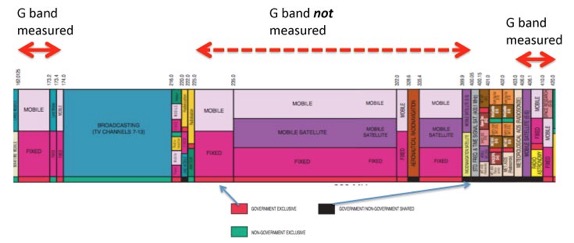
Why did IRAC not want to see data on the occupancy of that band? In almost all urban areas - the places where there is a shortage of commercial spectrum - the occupancy is low because the band is primarily used by military aircraft.
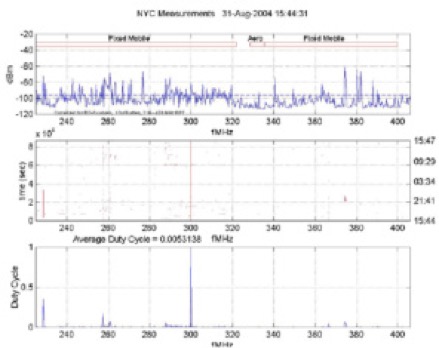
The above measurement by Shared Spectrum Corp. in New York City during the 2004 Republican National Convention shows the minimal use of this band even during a time of nearly unprecedented federal law enforcement and military presence in the city. FCC Spectrum Policy Task Force measurements showed similar results except in San Diego - the only major city with a military airfield near the center. (See Report of the Spectrum Efficiency Working Group, p. 10. The plot is labeled ‘ Occupancy of approximately 700 megahertz of spectrum below 1 GHz”, but actually is 200-900 MHz so the 225-400 MHz band is the left quarter of the horizontal axis. The report comments “it can be seen that there can be a large variation in spectrum use intensity within the spectrum below 1 GHz”.)
DoD’s concerns over measurement of this band are several.
- The low occupancy might lead naive policy makers to reallocate the band to other uses while the situation is more complicated. The band is heavily used in some rural areas for training and could be heavily used in emergencies even in urban areas. Thus they would argue that fire departments should not have the same spectrum loading as taxis since they have vital peak demands during emergencies. BUT, why hide the data and why not consider possible new spectrum use models based in “interruptible spectrum” concepts where DoD could preempt commercial use of the spectrum on a moment’s notice?
- Measurement of the band’s occupancy might reveal critical security information. Did the Shared Spectrum data above reveal such information? The Russians already have diplomatic facilities in New York, San Francisco, Seattle and Houston. The Chinese have them New York, Chicago, Houston, Los Angeles, and San Francisco. Thus key countries that have tensions with the US can readily measure for themselves the rough information given in spectrum occupancy studies. Withholding it from US policy makers and elected officials would not appear to be a valid security measure. There is no need to show which frequency channels are used vs. unused, a histogram of channel occupancies would be adequate for policy purposes. It is hard to believe that any channel occupancy data in this band reveals properly classified information.
- The US military has to negotiate for access to this band in other countries where we have bases and showing any “softness” in this band with respect to civil use might send the wrong signal to host countries. Probably. But spectrum is now a major input factor into GDP growth and making life easy for Politico-Military Affairs officers in US embassies overseas probably should not be a dominant factor in domestic spectrum decisions. New technologies could allow sharing of this band with preemption as discussed above and DoD and State department can explain to our allies how the new technology allows new options that they might wish to consider also.
During my nearly 25 yeas at FCC I never recall any NTIA hard data on the 225-400 MHz band use in urban areas - not even on a classified basis. Now without the promise of cognitive radio/dynamic spectrum access technology, sharing was not feasible for the reasons discussed above. But things have changed and new policy and technology options are now available. Shouldn’t we at least see some hard data on this key issue of how much this band is used in the areas of major spectrum congestion?

Photo from CIA Headquarters
UPDATE
See http://www.marcus-spectrum.com/Blog/files/SpecMeasCorr414.html
CTIA and SF: Round 3 - Antenna Aesthetics
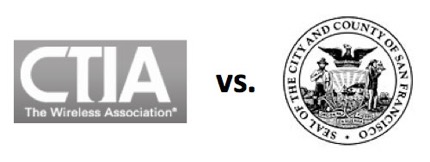
Readers may recall that cellular antenna design and the resulting local opposition has been a topic here for a long time. We also described how cellular mainstream member Ericsson tried to make a bold approach in antenna design that got interest in other countries, but none here. Cellular establishment members apparently prefer to hire lawyers and press for “shot clocks” and attempts at zoning preemption than to address their fundamental design problem: Their preferred antenna designs are incompatible with most suburban locations and the only alternative they have are very expensive custom designs they only want to use when in desperation. Your blogger’s approach to PCIA, the trade association representing most tower owners, was met with polite disinterest.
Universities seeking funding for novel design projects pairing EEs with architects to “think out of the box” on such design have come up with no funding from this multibillion dollar industry with perpetual antenna siting issues.
Since CTIA has already announced it will boycott SF over the cell phone labeling issue, they don’t have that threat in their quiver anymore. I suppose they can put their 4 law firms to work and sue over this issue also.
Maybe CTIA and its major members just prefer dealing with lawyers than with fundamental design problems. Cellular communications is not just part of our day to day lives, its infrastructure is part of the urban and suburban landscape. Should the industry try to come up with more pragmatic designs? Recall that at an FCC broadband hearing last year Jake MacLeod, a Bechtel VP, also stated that “we have reached the end of the line for current design concepts.” If this is what major contractors of the cellular establishment are saying then maybe the SF government is not so off the mark.
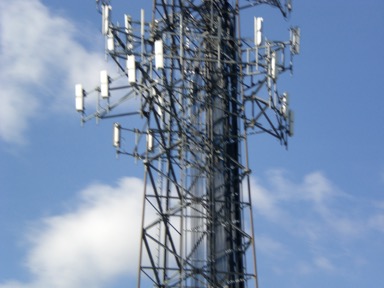
An antenna that “looks like it was designed by an engineer”
FCC IG: Light at the End of the Tunnel
Perhaps the 8th Floor finally listened, because on the FCC website now is a job announcement for the IG position. Now there is only a minimal 2 week (in August) open period which no doubt means that the new IG has already been preselected. But for a long time, this has been virtually standard practice in FCC for all senior civil service jobs and no doubt is common elsewhere in the federal government.
Hopefully this means that the new IG will be in place by the end of the year. We look forward to announcing who the selection is and hope the Commission follows our earlier recommendation that he/she be a career IG staffer from another agency with a great track record and no ties to the FCC leadership.
The NTIA CSMAC Interference Report: An Embarrassment to the President's Spectrum Policies
For reasons discussed below this report is, or at least should be, a major embarrassment to NTIA as it is inconsistent with both the President’s spectrum policies and the charter of the committee. It both evades some major issues and pushes the parochial agendas of some committee members without trying to relate them to the broader public interests.
The White House has said
“(N)ew technologies have the potential to free up spectrum from many of its existing uses. In combination with regulatory changes, new and emerging technologies can facilitate the repackaging, reallocation, and even sharing of spectrum. Reallocating spectrum to its most valuable use promises to be a win-win effort – creating value that not only spurs new innovations and creates new jobs, but also benefits existing spectrum users by allowing them to raise funds for transformative new investments.
This CSMAC report repeatedly takes a negative view towards all innovation and an absolute priority on protecting incumbents. For example on p. 7 it says, “If an incumbent service makes changes to its system’s architecture or modulation technique that results in new interference, then the spectrum to be used to establish any guardband protections should be provided by the service making such changes.” So no matter how outdated an incumbent’s equipment is, no matter how inefficiently an incumbent uses spectrum, no matter how lightly loaded an incumbent’s band is, the burden of protecting the incumbent always falls entirely on the new comer in the mind of CSMAC - which just happens to be dominated by incumbents.
Much of the report echoes the broadcast industry’s view on the database approach to TV whitespace, Docket 04-186. Perhaps not surprising since MSTV’s David Donovan, a lawyer, chaired this group. In private discussions, many CSMAC members observed that much of the long database discussion in the report was aimed at the FCC rulemaking and was irrelevant to the NTIA issues.
One might think that the “Interference Subcommittee” might spend some effort discussing what is “interference”? They dismiss this topic quickly:“Because of the different policy concerns, the Subcommittee makes no judgment as to the appropriate definition of interference that would trigger legal action. Accordingly, we use the term “interference’ in its generic sense.” (p.16)
Hey guys, maybe defining interference in detail is beyond your scope, but how about a few words on whether the current 47 CFR 2.1 definition is workable? What about the FCC view in the Wireless Innovation NOI:
“The viability of spectrum access for new radio services often centers on whether the new service may cause harmful interference to incumbent services. This can lead to delays through protracted rule making proceedings that can create uncertainty and discourage investment. Are there ways the Commission can improve upon this process?” (para. 34)
Does this issue apply to NTIA processes also? Are NTIA harmful interference determinations any faster or more transparent than FCC ones? Will sharing of Government spectrum by technical innovators be that much more attractive than allocations in NG spectrum? CSMAC - the world wonders?
The report was not content at sniping at the TV WSD intruders, it appears Mr. Donovan gave “professional courtesy” to his peers in the cellular establishment since cellular carriers and their allies were also well represented amount the committee members. Thus the report also took a cheap shot at the AWS-3 proceeding saying
•There is widespread consensus on the mechanisms and dangers of creating interference when licensing services that employ different duplexing technologies in adjacent spectrum.
•Industry stakeholders recently demonstrated the risks associated with plans to permit TDD operations in AWS-3 spectrum, without adequate allowances to protect adjacent AWS-1 FDD operations. (emphasis added)
Note the use of the word “stakeholders” here rather than “incumbents”. Don’t the stakeholders in FCC proceedings include also the public who could benefit from new service and the advocates of new service? The use of “stakeholders” in the report draft clearly shows the consistent bias in favor of incumbents. In any case, the demonstration was that referred to is controversial and the issue has not been resolved by FCC almost 2 years later.
Does the Interference Committee have any views at all on whether intersystem interference should be judged always on worst case/“minimum coupling loss” geometry or whether in some circumstances stochastic/probabilistic modeling should be used as it is from time to time in CEPT and ITU studies?
Filters have a big impact on all types of interference other than cochannel interference. Does the committee have any thoughts on whether filters are getting better and how that might impact sharing and guardbands?
Many types of wireless equipment now have a service life of a few years. Should this be taken into account in sharing and guardband determinations as the major cellular carriers have argued that PCS H block entrants can use increased power after existing handsets are replaced with newer models with better intermodulation immunity?
Finally, since this is a report on both interference and DSA, shouldn’t it at least mention the observation of Preston Marshall, formerly of DARPA, that cognitive radios could be designed to select not just idle frequencies but idle frequencies that will not cause interference to receivers with limited interference rejection capabilities that are nearby in frequency and space ?
John Muleta, former Chief of FCC/WTB, and I wrote a statement on this for the CSMAC that received little interest at the meeting in the rush to approve the flawed report. Readers might want to compare it with the report draft and draw their own conclusions. Please tell us what you think.
We will post a link to the final version of the report when it is released.
[MSS has done work for M2Z Networks and Adaptrum, Inc., but this post is not part of that work and is solely the view of MSS.]
NSF Contemplates Increased Research in Spectrum Access Technology
The National Science Foundation (NSF) is contemplating a major increase in funding in spectrum access research in conjunction with the presidential initiatives in this area. I just attended a 3 day workshop at NSF headquarters that considered possible directions for such a program. The presence of Commerce Secretary Locke and FCC Commissioner Baker at this meeting shows high level interest in the activity.
I will link here to the conclusions of the workshop when they are finished and published. Meanwhile, I will give my suggestions, many of which “got traction” at the workshop, in the hope that they might interest other researchers.
=====
Here's a list of research areas I have been working on for a while. You may wish to consider some at the conference. These are based on my experience at FCC and I have no vested interest in any of them other than intellectual curiosity.
1. Combining niche wireless applications into more general systems to improve spectrum efficiency. Today’s internet carries a wide variety of information flows while wireless systems are more narrow, leading to parallel “silo”-like allocations. Can we integrate wireless microphones, weather balloons, and other applications intermittent in time and space into broader systems.
2.Rethinking design of RF illumination of suburbia. (neé cellular base station design) in order to provide 10-20 wireless services from towers spaced on about 0.5-1.0 mile grid and keeping visual design compatible to suburbia. In reality, local opposition to cell tower construction is a major factor that slows wireless availability. Should include the impact of pfd regulation vice present eirp regulation as the higher frequencies now used for mobile services permit CSC2 antenna designs on. Excessive fs near present base stations limits spectrum efficiency with realistic receivers.
3. Radar systems occupy a large amount of spectrum and sharing with incumbent systems is very difficult. Simultaneous design of radar systems and communications systems so that they can share the same spectrum based on highly directional nature of radar emissions. Enable intermittent packetized communications access to radar spectrum and determine what backlobe requirements would be needed for radar to share on a win-win basis.
4. Filters and spectrum efficiency: Filters, in both transmitters and receivers, have a major impact on spectrum efficiency, yet are rarely discussed. There is no “Moore's law” like formulation of how filters for transmitters and receivers have improved over the decades. Yet they have. We need both a Formulate a figure of merit for filters (Q is a good start, but too simple) and a clear theory on how filter improvement translates into spectrum efficiency.
5. Cognitive radio concepts to select freq to protect receivers with limited dynamic range and adjacent channel rejection. This will significantly reduce receiver cost and allow greater spectrum use in real world.
6. Propagation and cognitive radio: Classic propagation models focus on single paths, yet sensing-based cognitive radios have multiple correlated. Better understanding of loss uncertainty and these correlations will allow us to predict CR performance better without expensive field tests for each system. Determine how existing propagation models need to be expanded for CR performance prediction and specify a measurement program to develop needed data.
Sprint Breaks with CTIA Peers to Actively Promote Driving Safety
 Sprint has taken a very different path on cellphone use and driving safety than CTIA and its other large members. On May 4, 2010, Sprint announced
Sprint has taken a very different path on cellphone use and driving safety than CTIA and its other large members. On May 4, 2010, Sprint announced“Five years after creating a free interactive program - Focus on Driving - to educate teenagers on the dangers of driver distraction, Sprint (NYSE:S) is expanding its mission to support two nationwide programs that educate teenagers and adults of all ages on the importance of safe driving in today's wireless world.”
Thus while CTIA believes “ text-messaging while driving is incompatible with safe driving” and supports proposals to “restrict or limit cellular use by inexperienced or novice drivers” it also says “the wireless industry is neutral on outright bans of cellular use while driving and hands-free legislation.” Not only is the CTIA neutral on legislative bans, its public service announcements only deal with teen issues. Thus CTIA does not want to point out any dangers of cell phone use while driving for “experienced drivers”.
Sprint is a cosponsor of Oprah’s No Phone Zone website and its “No Phone Zone Pledge”
Just like VZW should be praised for breaking with CTIA on its view that SAR data should be buried since any FCC approved cellphone is “safe”, Sprint deserves praise from breaking with the “party line” here and focusing of the safety of its customers and the public.
The site cosponsored by Sprint also donates all profits from its sales of merchandise to FocusDriven which “raises awareness and supports victims of motor vehicle crashes involving drivers using cell phones.” FocusDriven will probably not be invited to the CTIA convention - never again to be held in SF - since their site has the following message:
“Each year, thousands of families suffer the loss of loved ones needlessly at the hands of drivers distracted by their cell phones. Whether texting, using hands-free or handheld phones, these drivers not only put their lives on the line, but they risk killing others on the road.
FocusDriven provides victims of cell phone distracted drivers, and their friends and families, with an outlet for sharing their stories. We also provide those interested in this issue with opportunities to get involved.
FocusDriven can help you petition your state legislation; educate your friends, families and coworkers about the hazards of distracted driving; or share your story with state representatives to help support legislation for safer roadways.”
FocusDriven supporters and advocates know, and many have experienced, the very real consequences of drivers distracted by their cell phones. We ask you to make the pledge to not drive distracted, share what you learn on our site with those you know and get involved to help make our nation’s roads safer.
While ex parte Rulemaking & Enforcement Complaint Linger in Limbo, MSTV Alternates Between Compliance and Its Old Ways
47 C.F.R. 1.1206(b)(2): Oral presentations. A person who makes an oral ex parte presentation subject to this section that presents data or arguments not already reflected in that person's written comments, memoranda or other filings in that proceeding shall, no later than the next business day after the presentation, submit to the Commission's Secretary, an original and one copy of a memorandum which summarizes the new data or arguments. (Emphasis added)
Previously we have written about our numerous complaints about MSTV’s past flagrant violation of the Commission’s ex parte rules (significantly more than any other party we are aware of), the FCC/OGC staff’s preference to dismiss such complaints out of hand in an apparently arbitrary and capricious manner, and our pending Petition for Review on this matter that has been pending in 8th Floor circulation since 02/25/2010. (In fairness to the OGC staffers involved, they may just be acting at the behest of political appointees.)
Curious readers might be wondering how MSTV is behaving during the pendency of this matter. Have they cleaned house and become perfectly in compliance as NAB has been for a long time? Or have they noticed that in the more than 3 years since these original complaints were filed that they have escaped all criticism, let alone any penalties?
The answer: A little of both as seen below.
MSTV has returned to somewhat near the mainstream of compliance, but not the letter perfect level of NAB. They now often file ex parte statements the same day as for the meeting as shown at left. Most filings are now made within the deadline of Section 1.1206(b)(2).
However, March was a bad month for these fabled protectors of the rights of large TV broadcasters against the advocates of broadband for all. In March all the following filings were late:
http://fjallfoss.fcc.gov/ecfs/document/view?id=7020397659
http://fjallfoss.fcc.gov/ecfs/document/view?id=7020397641
http://fjallfoss.fcc.gov/ecfs/document/view?id=7020397663
http://fjallfoss.fcc.gov/ecfs/document/view?id=7020397644
http://fjallfoss.fcc.gov/ecfs/document/view?id=7020397654
http://fjallfoss.fcc.gov/ecfs/document/view?id=7020397638
Is there at the very least a “by your leave” apology for these late filings, perhaps blaming a dog for eating some paper? Not that we can find so far.
Here are some other late MSTV filings within the past year:
http://fjallfoss.fcc.gov/ecfs/document/view?id=7020352105
http://fjallfoss.fcc.gov/ecfs/document/view?id=7020352104
http://fjallfoss.fcc.gov/ecfs/document/view?id=7020352103
http://fjallfoss.fcc.gov/ecfs/document/view?id=7020036571
http://fjallfoss.fcc.gov/ecfs/document/view?id=7020036570
http://fjallfoss.fcc.gov/ecfs/document/view?id=7020036569
http://fjallfoss.fcc.gov/ecfs/document/view?id=7020036568
[Note that some of these filings may be duplicates filed repeatedly. However, I do not believe that FCC Rules permits multiple late filings of the same document as a remedy for lateness. Indeed, multiple filings of the same document complicates the work of both the Commission and other parties unless they contain a correction of a previous error or omission. It is customary in FCC practice to state that is a filing is a correction of a previous filing. None of the above filings give any indication that they are corrections]
Thus out of 101 ex parte filings in the past year, a few joint with the letter perfect NAB, MSTV, the subject of a longstanding ex parte complaint, was apparently late on 13 -- even while their previous performance was under review at FCC. But since MSTV has never received as much as a warning note from the Commission staff on previous apparent violations, they probably have logically assumed that they are exempt from compliance. It is the clear Pavlovian conclusion from FCC behavior.
Thus it is interesting to read a 7/16/10 comment, actually a late filed comment, from the FCBA Access to Government Committee that says,
While the FCC should enforce its rules, including the ex parte rules, there is no demonstrated need for increased sanctions or a dedicated effort to enhanced enforcement. The FCC should be able to continue to address any violations within its existing remedies.
FCBA guys: It is clear that in the 30 years since the FCC adopted ex parte rules it has consistently shown zero interest in enforcing them. Can you point to any enforcement action FCC has ever taken?
The FCBA group also states
For instance, the NPRM asks for comment on requiring staff filings following ex parte presentations. In our experience, this would be burdensome to staff and would provide a disincentive for staff members to meet with the public. While staff members should be free to submit an ex parte notice, they should not be required to do so.
FCBA guys: Yes there are advantages of the unique system FCC has with respect to FCBA members getting quick appointments with FCC staff. But in this day of e-mail is that so important? Every other federal agency that does rulemaking uses an approach where the staff summarizes the ex parte meeting. If you want the current system to continue shouldn’t you help FCC increase its compliance with respect to your membership? Continued FCC tolerance of the few bad actors could ruin it for all! There appears to be a “code of silence” among the FCBA membership about ex parte complaints not withstanding the requirements of §1.1214
Sec. 1.1214 Disclosure of information concerning violations of this subpart.
Any party to a proceeding or any Commission employee who has substantial reason to believe that any violation of this subpart has been solicited, attempted, or committed shall promptly advise the Office of General Counsel in writing of all the facts and circumstances which are known to him or her.(Emphasis added)
Does the FCBA leadership want us to believe that their their members in the past 30 years have never had “ substantial reason to believe that any violation of this subpart has been solicited, attempted, or committed”? I am willing to believe that compliance might be in the 90% range, but it isn’t perfect.
Related MSS filing in ex parte rulemaking (Docket 10-43)
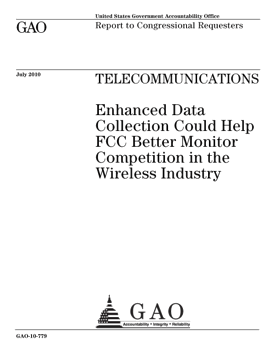
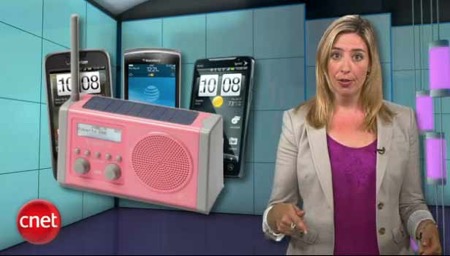

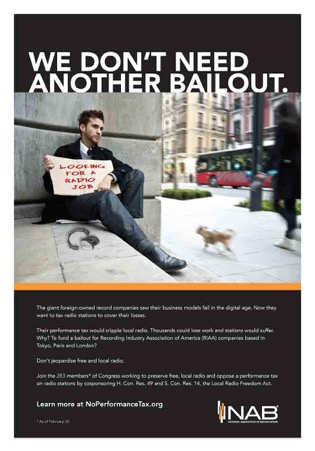
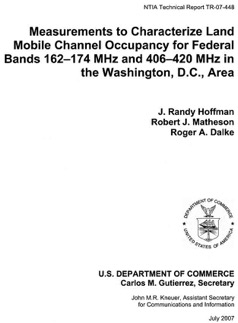


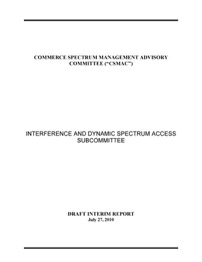

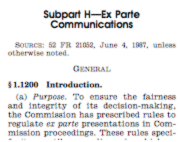
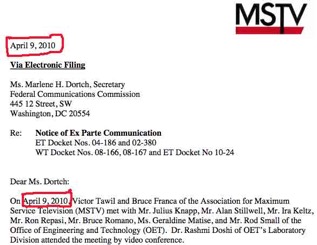
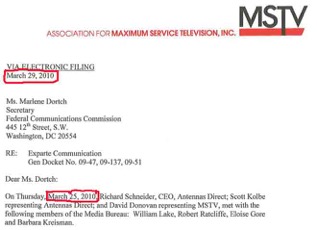


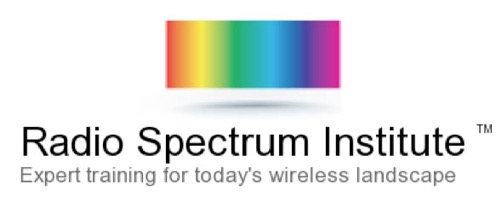


![Validate my RSS feed [Valid RSS]](valid-rss-rogers.png)

